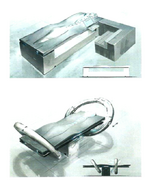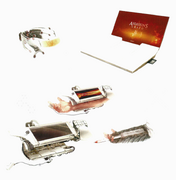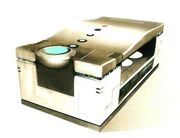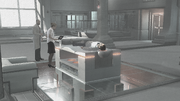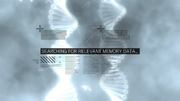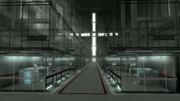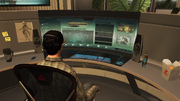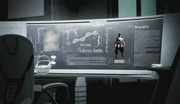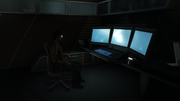- "You're inside the Animus. It's a projector which renders genetic memories in three dimensions."
- ―Warren Vidic to Desmond Miles, 2012.[src]
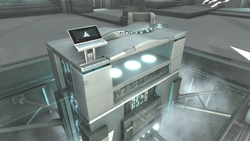
The Animus 1.28
The Animus (plural: Animi) is a virtual reality machine rediscovered, developed, and sold by Abstergo Industries. It allows the user to read a subject's genetic memory, and project it onto an external screen in three dimensions.
The machine was notably used in Abstergo's Animus Project and the Animi Training Program. The former analyzed the genetic memories of several select subjects, usually to gain information on the Assassin Order or on Pieces of Eden, while the latter was used for the training of Abstergo employees.
A newer model of the Animus, known as the Animus Omega, was developed and distributed commercially by Abstergo as an entertainment console. It was compatible with video games consisting of recorded memories, and was intended to be used to influence the general public on the behalf of the Templars.
History
Early Animi
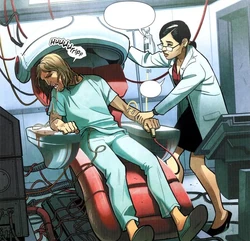
The Animus' 2000 model
The Animus was created by Abstergo Industries in the latter half of the 20th century, basing it on previously discovered First Civilization technology. Although at least partially influenced by the discovery of the Memory Seals, the software architecture used by the Animus is not based upon them.[1] Dr. Warren Vidic's leading authority on genetic memory guided the machine's development and so he became the overseer of the Animus Project.[2]
While working in Moscow in 1977, William Miles stole a copy of an early Animus blueprint, but was chased by Templars. Meeting a fellow Assassin in the city zoo, William gave her the designs before making his escape, telling her to build the Animus before the Templars could and to keep him informed of her progress. The woman, who was an Assassin scientist in nearby Protvino, was eventually able to build her own machine off of these plans.[3]
The earliest known use of an Animus was in 1980, when Dr. Vidic began his experiments with an unknown male codenamed Subject 1. It was from these sessions that Abstergo was eventually able to extract the genetic memories of Aveline de Grandpré. Unfortunately, the Animus was extremely unstable, causing the subject to go into a fatal seizure. To counter the setback, Vidic wiretapped the offices and laboratories of his colleague Aileen Bock, using her work with the Surrogate Initiative to further his own research.[1]
By 1983,[3] Vidic had developed a more stable version of the Animus and used it to manipulate the genetic memory of Subject 4 of the Animus Project; Daniel Cross.[4] Since then, the machine has gone through several major cosmetic and technical alterations, but even by 2012, Abstergo had not yet managed to perfect it.[2]
Meanwhile, the Russian Assassin who had received the blueprints from William Miles had successfully constructed her own Animus, and began testing it on her fellow Assassins in her cell. However, most of them lost their minds, unaware of the effects of prolonged exposure to the Animus. In an effort to understand more about the machine, the woman subjected herself to the Animus, but also went mad, leading her to eventually force every member of her cell into the machine. Only her daughter Galina kept her sanity, as the cell quickly became little more than a band of feral killers, losing all contact with the outside world.[3]
By 2000, the appearance of the Animus bore a resemblance to a chair,[4] and required a lot of external wiring to properly function.[5] This version of the Animus was used by Daniel Cross upon his return to Abstergo's Philadelphia facility in November 2000.[4]
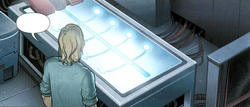
The Animus model in 2002
In the two subsequent years, the machine underwent major technological and visual changes yet again. As noted by Vidic's assistant Dr. Sung, subjects who were used to the model commissioned in 2000 would have difficulty interfacing with the newer model. The newer model bore a closer resemblance to a bed and had a chrome-colored appearance, though a cushion was nonetheless used for the subject's comfort.[5]
Animus 1.0
By 2002, Abstergo had also begun to produce Animi in greater numbers. A large Animi room had been created in their Philadelphia facility,[5] and another one later in their Rome facility.[6] The Animi room in Philadelphia was utilized to relive the memories of Assassins captured during the Great Purge, including Paul Bellamy.[5]
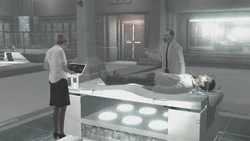
Desmond Miles using the Animus 1.28
Over the course of the next ten years, the appearance of the Animus only received minor updates. In 2012, the Animus had been updated to version 1.28, and was created to be more comfortable than previous models. This model was notably used for the Animus Project inside the Rome facility's laboratory,[2] and later in the Animi Training Program in the Rome facility's Animi room.[7]
When in use, the Animus rotated a glass panel over the head of the user, on which the genetic memories being accessed were projected. The Animus 1.28 was not very energy-efficient, however, and was prone to overheating after extended use; upon overheating, the machine's blue lighting flashed orange instead.[2]
Animus 2.0
- "Baby's twice as awesome as anything you'll find at Abstergo!"
- ―Rebecca Crane, speaking of her Animus, 2012.[src]
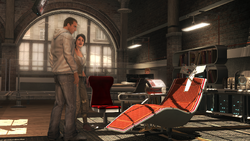
Rebecca introducing Desmond her version of the Animus
The Animus 2.0 was an upgraded model of the Animus that had been developed by the Assassins in 2012. According to its developer and maintainer, Rebecca Crane, her "Baby" was much better than the ones which were used at Abstergo. She had began to develop it with partial schematics sent by Lucy Stillman, the Assassins' spy at Abstergo, and had improvised on the rest.[6]
The Animus 2.0 was different in many ways to the Animus 1.28, both physically and within the three-dimensional reality it projected. For example, the background color of the loading sequence changed from an icy blue to white, with the entire region of a memory slowly loading up each time one was accessed.[6]
The external properties of the Animus also changed greatly, with the 2.0 returning to a chair-like configuration, while offering increased comfort to the user. However, due to this, a catheter in the user's arm was required, in order to access genetic memories and link the user into the Animus itself. Despite these improvements, the Animus still suffered from lagged translation software, and was unable to prevent the Bleeding Effect over prolonged use.[6]

Desmond using the Animus 2.01 inside the van
The new Animus model allowed for remote interaction from an outside source, which included uploading database-like information packets for the user to view. During Desmond Miles' time with the Assassins in 2012, Shaun Hastings, a historian and tactician for the Assassins, made great use of this utility, providing countless files on historical figures and locations.[6]
The Animus 2.03 was also used as a life support system for Desmond after he had fallen into a coma. At this time, Clay Kaczmarek's virtual intelligence took over the role of writing the Animus database articles.[8]
Animus 3.0
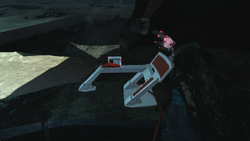
The Animus 3.0 set up inside the Grand Temple
Upon waking from his comatose state, Desmond entered the Animus 3.0 to relive the memories of yet another of his ancestors. As he did with the Animus 2.0, Shaun continued to write database entries for the Animus 3.0 system. The 3.0 upgrade was made during Desmond's time in a coma, and was mainly a software upgrade which included a new user interface and changes to the puppeteering motion controls. However, the hardware of the Animus remained the same as before.
The Animus did go through cosmetic changes, though nothing drastically different from the Animus 2.0. The main difference was that the Animus equipment, namely the head and arm rests, no longer needed to be attached to a chair in order to function, meaning that the Animus could be set up on almost any flat surface. This made it much more portable, being able to be carried down into the Grand Temple in a trio of boxes carried by Rebecca, Shaun and William Miles.[9]
Animus console
By late 2012, Animus and DDS technology had progressed to a point where it was possible to allow anybody to view the genetic memories of another individual, provided DNA was in storage.
Abstergo Entertainment, a public division of Abstergo Industries, utilized this technology by having consumers explore points of interest across history in order to obtain information, or to explore and upload their own genetic memories.
The Animus was available as a game console, offering an interactive experience similar to the Animi Training Program, or as a visor, offering a heads-up display of how people or locations appeared in the past, enabling a person to identify someone they had not seen in years. Abstergo also doctored information on the lives of historical figures they presented, leading to Erudito hacking the network to present the truth to players.[9][10]
Animus Omega
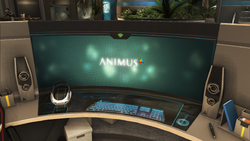
Animus Omega workstation in Montreal
In 2013, the Abstergo Entertainment division in Montreal utilized the Animus Omega in their research and analysis of genetic memories harvested from the DNA of Desmond Miles. The project was known internally as the Sample 17 Project.
The employees of the Montreal division were told the memories would be used to explore possibilities of new settings for Abstergo Entertainment's game products, while in reality, the data was being used by Abstergo Industries to locate information on the First Civilization and the Pieces of Eden.
It was also possible to hack into the Omega model's computer core, provided the hacker possessed the proper programs to do so. From October to December of 2013, the head of the Montreal facility's IT department, John Standish, instructed an Abstergo Entertainment research analyst to hack into an Animi and download a video file for the Assassins' benefit. Afterwards, it was possible for the analyst to hack into any unguarded Animus, revealing several hidden files throughout Abstergo's mainframe.[1]
Brahman V.R.

Jot Soora using the Brahman V.R.
In late 2013, Abstergo Industries made a multi-million dollar deal with Indian company MysoreTech, to release the Brahman V.R. onto the Asian market. It functioned similar to other Animus types, with the exception of being portable, and uploaded the genetic memory of all of its users into the Abstergo Cloud.
As such, Abstergo's primary goal was to find the memories of individuals who came into contact with the Koh-i-Noor, specifically Arbaaz Mir and Pyara Kaur.
Data Dump Scanner
- "The DDS is now in sync. Thank you for your patience. We hope you'll enjoy your experience."
- ―A DDS welcome message.[src]
The Data Dump Scanner, more commonly referred to as the DDS, was the software that, in conjunction with the Animus, allowed the user to relive extracted memories. The DDS could allow the user to relive any pre-recorded memories, regardless of whether they were blood related, through uploading the extracted memories from another person's genetic memory.[11]
The software was invented and used by Abstergo Industries, who used it in their Project Legacy to obtain information on the Assassins and Pieces of Eden, among other things,[11] and in their Animi Training Program to train their agents.[7] Memories used in the projects had been previously extracted from certain individuals by the company.[11]
The DDS technology, combined with the Animus interface, paved the way for the creation of Helix.[12]
Usability
- "When we switched the Animus control scheme to use standard videogame controls, I guessed that the subject's learning curve would improve; but the increased acclimatization rate we're seeing with these slacker types is astounding."
- ―Warren Vidic.[src]
At first, Abstergo found their test subjects having difficulty adapting to the Animus control scheme, so they changed the controls to match that of gaming consoles, projecting the controls into the users' mind and significantly improving their response rate, allowing for quicker adaption.[13]
Despite the core of the technology merely allowing the user to view genetic memories encoded into their DNA, the Animus also allowed the user a degree of interaction with the environment they were viewing. Although this was limited in the Abstergo model, the level of interaction increased greatly in the Animus 2.0, allowing the user to choose the pace at which they progressed through the memories.[6]
Synchronization
- Main article: Synchronization
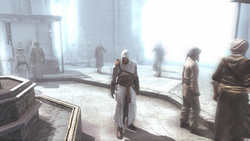
Desmond's synchronization with Altaïr being unstable
As the user of the Animus was able to interact with the environment in which they were viewing, the concept of synchronization was brought into play.
Failure to follow the memories of an ancestor exactly often resulted in a temporary decrease in synchronization with said ancestor, and continuing such actions would lead to complete desynchronization. This in turn forced the user to reload the memory from an earlier point.[2]
The Animus was designed to put up barriers when the user attempted to interact with an environment the ancestor had not entered at that particular moment in their life, and was also capable of ejecting the user in extreme cases of desynchronization.[2][6]
Side effects
- Main article: Bleeding Effect
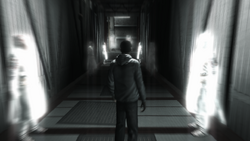
Desmond suffering from the Bleeding Effect
Use of any variation of the Animus technology was prone to cause mental instability within its users. Prolonged use caused a condition known as the "Bleeding Effect", which blended the real-time and genetic memories of the user, transferring thoughts, skills and experiences from the ancestor to the descendant.[2]
Continued and uninterrupted use of the Animus often resulted in mental degradation of the subject, and in extreme cases, total psychological instability.[2][6]
Trivia
- Animus is a Latin term referring to "the mind" in a variety of senses, ranging from the intellect, the will, or the soul.
- In Assassin's Creed, the Animus acted only as a machine and plot element, allowing Desmond to play through Altaïr Ibn-La'Ahad's memories; in Assassin's Creed II, its use was expanded. The Animus became an interface to a new world, including information about historical locations, people, and time periods. It was also developed as a modular tool, allowing Ubisoft to explore any aspect, be it additional memories, multiplayer or other content.[14]
- A different design of the Animus was used by Jonathan Hawk in the third volume of the Les Deux Royaumes comic series. However this design is not canon.
- In the Animus 1.28, sprinting long enough during the interactive loading sequence would rid the Animus of the random pieces of data flickering around, showing only a blue, foggy expanse. Additionally, Altaïr could hit an invisible barrier.
- While replaying memory blocks in Assassin's Creed, an unusual red-beige tinted abnormality showed itself for one frame as the memory was initiated. This was the inside of Desmond's face, as the camera for the initiation sequence was shown in three ways: starting back and moving forward, starting front and moving backwards, and upside-down. When the camera moved slightly backwards, it glitched into Desmond's face. His eyebrows, nose, and lips were easily seen if the screen was frozen.
- At one point, Desmond praised the Animus 2.0 for having subtitles to make up for the laggy translation software. This was a reference to how there was no option for subtitles in the Animus 1.28.
- Once Ezio Auditore da Firenze's story was completed in Assassin's Creed: Brotherhood, the option to leave the Animus was removed from its main menu due to Desmond's comatose state.
- The Animus 1.28 made an appearance in every main game, up until Assassin's Creed IV: Black Flag; it was used by Desmond in Assassin's Creed and Assassin's Creed II, and then by Abstergo employees in Assassin's Creed: Brotherhood, Assassin's Creed: Revelations, and Assassin's Creed III. It was also showcased among the older Animus models, in the files obtained by the Abstergo Entertainment research analyst, in Black Flag.
Gallery
References
- ↑ 1.0 1.1 1.2 Assassin's Creed IV: Black Flag
- ↑ 2.0 2.1 2.2 2.3 2.4 2.5 2.6 2.7 Assassin's Creed
- ↑ 3.0 3.1 3.2 Assassin's Creed Initiates
- ↑ 4.0 4.1 4.2 Assassin's Creed: The Fall - Issue #3
- ↑ 5.0 5.1 5.2 5.3 Assassin's Creed: The Chain
- ↑ 6.0 6.1 6.2 6.3 6.4 6.5 6.6 6.7 Assassin's Creed II
- ↑ 7.0 7.1 Assassin's Creed: Brotherhood
- ↑ Assassin's Creed: Revelations
- ↑ 9.0 9.1 Assassin's Creed III
- ↑ Assassin's Creed III: Liberation
- ↑ 11.0 11.1 11.2 Assassin's Creed: Project Legacy
- ↑ Assassin's Creed: Syndicate - Database: Álvaro Gramática
- ↑ Assassin's Creed game manual
- ↑ IGTV: Behind The Scenes - Assassin's Creed 2
| |||||||||||||||||||||||||
| |||||||||||||||||||||||||
| ||||||||||||||||||||||||||||
| |||||||||||||||||||||||||||||||||||||
| |||||||||||||||||||||||||||||||||||||
| |||||||||||||||||||||||||||||||||||||
| ||||||||||||||||||||||||||||||||||||||||
| ||||||||||||||||||||||||||||||||||
| ||||||||||||||||||||||||||||||||||||||||
| |||||||||||||||||||||||||||||||
| ||||||||||||||||||||||||||||


